Jeremy Miller's Blog, page 29
September 20, 2016
13 Examples of the Best Company Names

A company’s name is one of its most valuable assets. It’s how we identify with the brand. And a great brand name makes the company more memorable and desirable.
As you develop your company’s brand name draw inspiration from some of the greats. Here are 13 examples of the best company names:

In 2015 Google launched a new holding company, Alphabet. The purpose of the Holdco is to provide greater transparency to Google’s growing list of interests such as Nest, Calico, Google X, and Google Ventures.
Alphabet won’t become a household name, but it’s a brilliant name for a house of brands. It’s a whimsical play on a conglomerate’s diverse interests and companies. G is for Google, N is for Nest, you get the idea.

Jeff Bezos founded Amazon.com to be the “everything store.” He selected the name “Amazon” because it was a place that was perceived as exotic and different. The Amazon River is the largest river in the world, and Bezos planned to make his store the biggest in the world.
Amazon is a great company name, because it’s experiential. The word has nothing to do with retail and ecommerce, which makes it more memorable.

Apple may be one of the most recognized companies in the world, but that doesn’t take away from the fact that Apple is a great brand name.
Apple is another experiential brand name. It’s fun to say, because of the double hard consonants, ap-ple. It also is clearly articulated with a simple illustration, the Apple logo.

BlackBerry was a great brand, and its keyboard was one of its defining features. People loved their BlackBerry keyboards, and many resisted going to iPhone and Android because those devices lacked a keyboard.
The name BlackBerry was chosen because of the original product design. The keyboard buttons resembled a blackberry fruit. The device had a cute shape, and the name fit it perfectly.

Buffer is a social media sharing tool. The service literally lets you buffer your social media posts. Load up the queue, and it releases your tweets and Facebook updates on a prescribed schedule.
Buffer is both a functional brand name with experiential qualities. The brand name does an excellent job positioning the services.

Caterpillar is another experiential brand name. It immediately differentiates the line of heavy equipment. And customers affectionately refer to the brand simply as “Cat.”
The brand name was chosen in 1925. A company photographer noticed the tractor’s tracks resembled a caterpillar moving along the ground. The name stuck.

Google is an invented word. The name was originally “googol”, which is the equivalent of ten raised to the power of a hundred. Googol was proposed to reflect the company’s mission to organize the immense amount of information available online.
The name “Google” happened by accident. Googol was misspelled when the domain name was registered, but Larry Page liked how it looked. Google stuck.
Google works, because it’s distinct and fun to say. Also, it visually works because Google extended the name to visually represent the number of results in a search: Gooooooogle.

George Eastman invented the word Kodak. Eastman liked the letter K, and believed it was a strong and incisive letter. He tried out various combinations of words starting and ending with “K”. He saw three advantages in the Kodak name: easy to trademark, easy to pronounce, no other uses of the word.
Kodak is a great brand name for all the reasons George Eastman described. It’s distinct and phonetically pleasing.
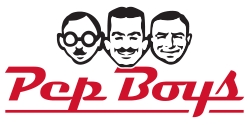
Peps Boys was originally called, “Pep Auto Supplies.” The name was changed because of a policeman who worked near the store. As the story goes, every time the officer stopped a car for not having an oil wick burning during nighttime hours he would tell the driver, “Go see the boys at Pep” for a replacement.
The name is whimsical, and the double hard consonants makes it memorable.

Smucker’s is named after its founder, Jerome Monroe Smucker.
The name sticks for two reasons. One, great advertising like, “With a name like Smucker’s, it has to be good!” The company doesn’t take its name too seriously, and that’s helped to form a fun, wholesome brand.
Second, the hard consonant differentiates it from competing brands like Welch’s. The consonant makes it fun to say and easier to remember.
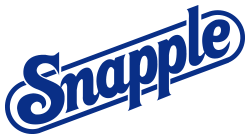
Snapple was originally called Unadulterated Food Products. Definitely a boring, nondescript brand name.
The Snapple name came from one of the company’s products, a carbonated apple juice. The founders’ described it as a “snappy apple” drink, which was then shortened to Snapple.
The name is great, because it’s an invented word that phonetically makes sense. You only have to hear the name once, and it sticks in your mind.
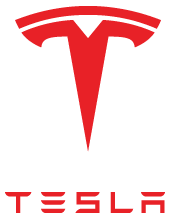
Tesla Motors was named after Nikola Tesla, the inventor of the induction motor and alternating-current (AC) power transmission.
Nikola Tesla is synonymous with electricity. The power of relevancy of the inventor’s personal brand provided Tesla Motors immediate gravitas. It signals this company is inventing a new breed of cars based on electric power.
It’s an evocative name with a hat tip to an incredible inventor.

Twitter is one of the best names for a social media company. The word clearly conveys the brand experience.
Jack Dorsey, co-founder of Twitter, explains “We looked in the dictionary for words around it and we came across the word ‘twitter’ and it was just perfect. The definition was ‘a short burst of inconsequential information’, and ‘chirps from birds’. And that’s exactly what the product was.”
September 13, 2016
Family Business Branding: It’s a Mark of Trust

If you have an opportunity to call your company a family business, do it. Customers trust family businesses more.
The family business brand is a mark of trust. It may not be the reason why a customer buys a company’s products and services, but it can enhance the brand loyalty and affinity.
A distinct family business brand creates a halo effect. According to a research report by the Institute for Family Business, the family business brand enhances perceptions of trustworthiness, social responsibility, quality-orientation, and customer-orientation.
The report also found that it didn’t matter if the brand was B2B or B2C. Two-thirds of family businesses find their corporate reputation is superior to non-family competitors.
A family business may not be the largest brand in the category, but the family business brand adds weight. It creates a story and legacy that can place the business on equal footing with its larger rivals.
Families Are Messy
I know a few family owned business that refuse to acknowledge they are family businesses publicly. They believe that family doesn’t mean professional.
This can be true. Families are inherently messy. We all have our issues, and sometimes that can spill into the operating company. The irony is the messy factor can humanize the brand.
Public companies are often called “faceless” and “soulless.” This isn’t exactly fair, but it highlights how the family story enhances the brand. It creates a point of reference that we can know, like, and trust.
The caveat is messy is fine unless the behavior is fraudulent or incompetent. A family has a responsibility to the brand. They are the holders of the founder’s vision, and the family brand is intrinsically linked to the business brand.
A Legacy of Trust
Simply calling your business a “family business” isn’t enough to enhance the brand. The family brand and the business brand have to be linked.
The family brand is the human element. It enhances the business brand in three key areas:
Heritage: The history of the business and family, and the legacy in the community.
Innovation: How the company and family evolved, changed, and grew. As well as its commitment to innovating and winning.
Values: What the family believes, and its responsibility for the business and community.
These three elements all point towards longevity. Family businesses are in it for the long haul, and that creates a legacy.
Publicly owned companies, on the other hand, are under ever increasing public scrutiny:
Excessive executive compensation and bonuses.
Revelations that corporations are paying low to no taxes.
Short-term thinking and quarter-to-quarter decision making.
Big corporations are losing trust, while family businesses are gaining it. The family’s legacy elevates the brand and signals that this business is more committed to its customers, employees, and the community as a whole.
As markets commoditize use every advantage at your disposal. If you’ve got it, flaunt it. The family business brand is a mark of trust.
September 6, 2016
A Little Humor Goes a Long Way

It’s not easy being on the receiving end of an angry customer complaint, but a little humor goes a long way.
James Lloyd, for instance, was perturbed to discover his flight from Sydney to London included a 47 year layover in Bangkok. That’s not a typo. The travel service, Skyscanner, gave him an insane 413,786 hour layover.
Not excited about the prospects of spending the better part of his life traveling to London, Mr. Lloyd took to Facebook. He asked, “Hi Skyscanner. Just wondering what you’d recommend I do during the 47 year layover your website has suggested?”
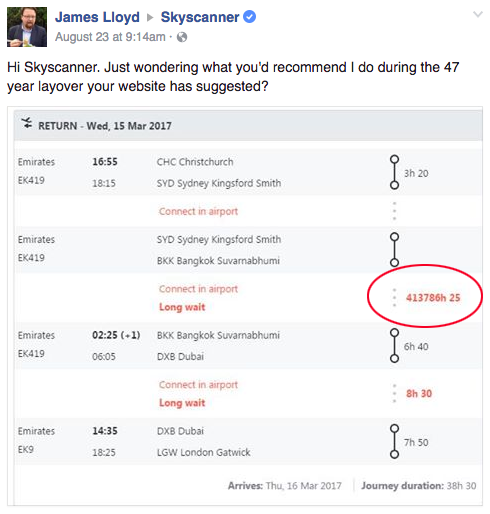
Instead of following social media customer service 101 — respond promptly and get the customer into a private chat — Skyscanner used humor. The support rep, Jen, offered Mr. Lloyd some things to do with his time in Bangkok.
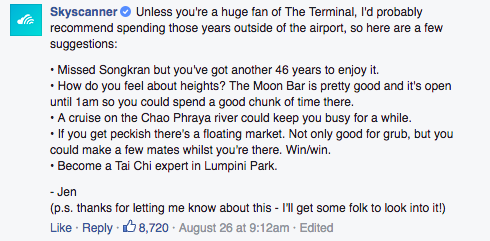
Not only did Jen’s wit and humor diffuse the situation, her response took off. Skyscanner’s customers took notice and began replying to the thread.
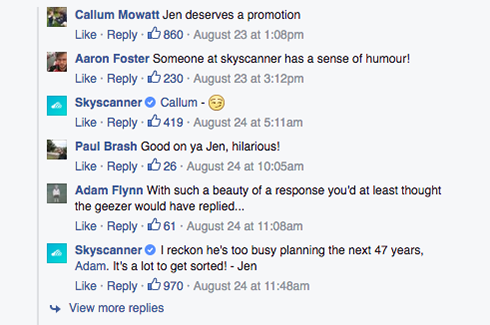
A little over a week later the post has over 21,000 likes, 3,400 shares, and 1,200 comments. Not only that, the thread was picked up by Mashable, which ballooned it into a global story. Skyscanner hit the PR jackpot. I hope Jen is getting a big, fat bonus.
Humor is a powerful tool, especially when delivered in a respectful, cheerful way. It lets customers know you are human too, and you’ll work to get the problem resolved.
I doubt Jen knew her response would have such a big impact, and that’s what makes it even more delightful. This was an authentic, playful interaction. And it reveals more about the Skyscanner brand and culture than any of its marketing.
Jen’s humor worked, because she was playing with the absurdity of the situation. She didn’t belittle the customer or make him the butt of the joke. She had some fun and then got to her core message, “Thanks for letting me know about this – I’ll get some folk to look into it!”
A bit of humor makes your brand even more human and likable. It reveals the personality of the people behind the brand, which cracks the facade of marketing. It let’s your customers see that there are real people working for them who really care.
I love this story. Let’s all take a page from Jen.
August 30, 2016
Marketing vs Sales: Who Really Drives Sales

“Salespeople drive sales” is a myth.
It’s simply untrue. Salespeople don’t generate demand for your products and services, they service it.
This may seem counterintuitive, but look at the primary tasks of a sales professional. Salespeople work the sales funnel, facilitate the buying process, negotiate and close.
Yes, you can delegate top of the funnel activities to your sales team, but they don’t have many tools to leverage. When salespeople don’t have any leads they cold call and network — both are pretty weak marketing options in a digital marketplace.
The top of the funnel, where we create demand, is marketing’s responsibility.
The 3T’s of Sales Performance
Exceptional sales talent is not enough to move the sales needle. Your company’s sales performance is predicated on three variables:
Territory
Timing
Talent
And their impact on your organization is in that order.
Territory: The market will dictate what it will buy. A weak sales rep in a great territory will outperform a superstar in a poor sales territory. The number one predictor of sales performance is territory.
Timing: The economy and market conditions influence sales potential. As the old saying goes, even turkeys can fly in a hurricane. Everyone does well in a hot market. On the other hand, a recession can hurt your sales performance.
Talent: Great salespeople do make a difference — when they’re selling the right product in the right market. There really is no substitute for great sales talent. Working with weak salespeople is like driving on bald tires. It doesn’t matter how hard you step on the gas, you just can’t get traction. Great salespeople make all the difference.
To Drive Sales Grow Territory
Territory, not talent, is the most important lever to push to improve sales performance.
Salespeople just don’t have the resources or tools to expand a territory’s potential. This is marketing’s responsibility.
There are lots strategies a brand can employ to increase territory demand. Here are three examples to give you some context and get the creative juices flowing:
Path of Search. Get your brand in front of more people, especially active buyers. Google AdWords and Facebook advertising are ideal in this pursuit, but there are plenty of other outlets to consider. Use the media, both free and paid, to make your brand appear to be everywhere within your desired market.
Stand on the Shoulders of Giants. Partner your way to greater brand awareness. Channel partnerships are ideal to increase visibility and credibility, because you are leveraging a larger, more recognized brand. These partnership are also valuable, because they open up new distribution channels. Who can your company partner with to reach new markets, engage more customers, and build greater brand awareness?
Try Before You Buy. Freemium models are ideal for undercutting the competition while giving your sales team direct access to potential customers. Get a customer to sign-up for a free product or service so that your sales team can up-sell them into a bigger solution.
Growing territory potential is a combination of marketing campaigns and product development. It requires looking at your market from a variety of angles, and finding ways to reach and engage every possible customer.
Sales and marketing aren’t competing in the pursuit of driving sales. Both are responsible for it. If marketing drives demand then the sales team will do what it does best, sell.
August 23, 2016
Dealing With Disruption

Disrupters are lionized. Companies like Uber and Tesla are held up as heroes. But they’re anomalies.
Chances are your company is not a disruptor, but it is facing disruption.
This was my challenge when I joined my family’s business. My parents founded an IT staffing agency in 1989. Through the nineties and early 2000s the business boomed, but when I joined the company in 2004 we were dealing with disruption.
We could see it in our sales numbers. In the nineties each of our sales reps closed a deal a week on average. They were successful, because they were diligent with their calls and developed solid client relationships. But in 2004 something shifted.
What used to take our sales guys a week to achieve was now taking them a month. Instead of closing 50 to 60 deals a year, they were closing 10 to 15 deals. It was a dramatic decline.
My mandate was to turn the business around. This lead us to reposition and rebrand the company, as well as develop an entirely new approach to business. Within a year of the rebrand the company rocketed back into growth mode, and we chased that wave until we sold the business in 2013.
The experience of rebranding my family’s business still weighs heavily on my mind. We weren’t being opportunistic or disruptive. We rebranded the company as a matter of survival. Our market was disrupted, and we had to evolve or die.
Disruption Demonetizes Industries
The recruiting industry is still reeling from the disruption we faced a decade ago.
Job boards, Google, and LinkedIn tipped the balance of power in the recruiting industry. In the nineties a staffing agency’s database was its competitive asset. Today resumes are cheap. Almost every resume is accessible in the public domain via LinkedIn.
The cheap, immediate access to talent had two devastating effects:
Surge of competition. Technology reduced the barriers of entry in the industry.
DIY Movement. Technology made it cost effective for companies to bring the recruiting function inhouse.
It was a double whammy. Not only were we competing with a host of new startups that were more than happy to undercut the market, we were competing against our clients.
The impact of the disruption has been alarming. In the nineties an average permanent placement agency (a recruiting agency that specializes in placing full time employees) was $10 to $25 million in revenue. In 2016 the average is less than $500,000. Basically, two Bobs in a basement.
Disruption is scary, because it can demonetize your industry.
Disruption Sparks a Chain Reaction
Peter Diamandis, author of Bold, defines the three stages that follow a disruption:
Demonetization: The removal of money from the equation.
Dematerialization: The removal of goods and services.
Democratization: When costs get so low the industry becomes free.
For instance, look at the map industry. A decade or so ago people bought maps. An AAA or CAA membership was valuable, because it provided useful mapping services such as tailored trip plans and routes for your vacation.
Not anymore. Everyone has access to enterprise class mapping systems. Google Maps is amazing and it’s free. Maps have been democratized.
Disruption triggers a chain reaction:
First it erodes the profitability of an industry, demonetization. Uber and ridesharing services are undercutting the taxi industry.
As the bottom of the market falls out we see the dematerialization of the industry. No more service providers. Check out the travel industry. Expedia and online booking services have largely displaced travel agents.
Finally the industry just shifts to free, democratization. Kodak did not survive the democratization of photography.
Dealing With Disruption
It’d be nice if your company was a disruptor, but it’s unlikely. Chances are your company will be on the receiving end of a disruption. And with the current pace of technology it’s more likely your company will be disrupted multiple times.
Being on the receiving end of a disruption is disconcerting. What I went through with in my family’s business has left lasting and a permanent marks. It’s made me acutely aware of what’s shifting in my marketplace and I constantly ask, “How do we win when the rules keep changing?”
Dealing with disruption is like executing a strategy without a map. You can’t rely on the lessons of the past, and you can’t predict the future. You have to navigate in the present. You can do this by asking three deep questions:
What do you want?
What won’t change?
What conventions can you challenge?
The three questions help you see the playing field from another angle, and help you redefine your brand and value proposition.
What you’re looking for is a new path to relevance. When your industry is going through the chain reaction of disruption — demonetization, dematerialization, democratization — it is challenging the very relevance of your business.
When the rules change you can either evolve or die.
This is a complex topic, but one that we are all dealing with. I’d like to hear your thoughts. Send me an email or a comment on Twitter, Facebook, or LinkedIn. How are you dealing with disruption?
August 16, 2016
Why Fit In When You Were Born To Stand Out?

Dr. Seuss said, “Why fit in when you were born to stand out?”
This is one of my favorite quotes, and it’s how I related to branding. Branding is a big, amorphous topic. It encapsulates design, language, strategy, and relationships. Branding has a lot of moving parts, but it’s energy is internal.
We build brands to stand out.
Let’s look at this idea from a personal branding context. Everyone has a personal brand. Even without trying you have a personal brand. It’s your reputation.
You may have a reputation as a hard worker, a creative person, a connector, or a person to call in a crisis. However people identify with you is your personal brand.
There’s a difference though between having a personal brand and personal branding. A personal brand is something you have by default, where as personal branding is something you work on and nurture.
People are interested in personal branding because they want to stand out. The status quo does not fulfill them. They possess a deep energy and desire to be something more, and they work on their brand, build it, and scale it. Personal branding is the steps we take to stand out.
The same is true for branding a corporation. Every company has a brand, but the companies that grow remarkable brands are deeply interested in branding.
Why Some Brands Are Better
I profiled over 150 companies from the United States to New Zealand to write Sticky Branding (the book).
I wanted to uncover how small- and mid-sized companies — companies that have a marketing budget, but not a vast one — grow remarkable brands. I didn’t care how Apple, Nike, or Starbucks grew their brands. I wanted to understand what mid-market companies were doing to stand out.
During the research process it became very clear: it’s no accident that some brands are better than others.
The companies that grow the best brands are the best marketers:
They invest more in their brands.
They make bigger bets.
They defend their brands.
They delight in serving their customers.
They love their brands.
The companies with the most remarkable brands are compelled. There’s something baked into the organization’s DNA to make the brand stand out.
Usually this energy and drive starts with the founder. The founder took Dr. Seuss’s quote to heart, and breathed it into the organization. Why fit in when you were born to stand out?
Branding is a process, but the drive to grow a brand is internal. It’s your drive to challenge the giants of your industry, delight customers, and stand out. This internal energy is what propels some people and companies to have brands that are better than their peers.
August 9, 2016
Why You Should Write Long Form Content (Hint: Google Loves It)

When I started blogging the advice was “keep it short.” Write articles in the 300 to 500 word range. Keep them simple, catchy, and easy to scan, because “nobody wants to read a big article online.”
The advice sounded practical, but I question it. The articles that make me the most money are long form content.
Last summer (2015) I ran a 4 week experiment to test “ultra long form content.” I published 4 articles that each had over 2,500 words:
Make Your Brand Iconic: The Power of Symbols in Branding
A Brand To Love: Brand Mascots Tug Your Heartstrings
Brand Metaphors: How To Engage Customers at a Deep, Visceral Level
Twelve months later these 4 posts are going strong, and are all in the top 20 most visited pages on Sticky Branding. What’s even more fascinating is one of the posts generated enough demand to create a new service: Brand Naming.
Google Rewards Long Content
Long form content may seem counterintuitive. For instance, BuzzFeed is the king of viral posts. They have headlines like “Kylie Jenner Revealed Her Ramen Recipe And People Are Losing Their Damn Minds,” or “The 21 Absolute Worst Things In the World.”
According to Kerry Jones of Marketing Land, “Short content reigns supreme on BuzzFeed. Of the top 100 articles, almost half were 300 words or less … This type of content is ideal for readers looking for simple, skimmable entertainment.”
BuzzFeed may be the king of viral content, but Google rewards well written long form content.
I first noticed this in Google Analytics. The 4 long form posts were generating much higher inbound traffic than most of my other content. So I tested the posts performance using Pardot’s Search Marketing Tools. I was shocked:
“Brand Mascots” was ranked #1 in Google’s search results
“Brand Naming” #3
“Brand Metaphors” #12
“Brand Symbols” #12
These were valuable search terms. Brand Naming, for instance, costs $4.88 per click in Google Adwords, and I was in the top 3 organically.
Long form content performs well, because it fulfills a user’s desire for answers. When we search a topic we’re not looking for linkbait entertainment. We want to find meaningful ideas and answers to solve problems. This is why long form content moves the sales needle.
When someone is looking for answers they spend more time on the content, digest it more, and are more likely to click deeper into your site. A viral post, on the other hand, is a different behavior set: see it, click it, share it, forget about it.
Amplify Long Form Content with Marketing Automation
One of my bad habits is I create content and forget about it. It’s a symptom of my editorial calendar. I am publishing at least an article a week, and tend to focus on what’s in front of me.
But a couple months ago I started receiving inquiries about brand naming services. It started with a request from a consumer goods company. I was a little taken aback, because I did not have a service page or any documentation on my website stating I offered the services.
Then it happened again and again and again. I was receiving 2 to 3 inquiries a week. After a little digging I realized it was traffic coming in from the from the long form content experiment.
I am a firm believer that the market will tell you what it wants to buy, but I wanted to prove the theory before committing to a new service. Using Pardot I created a landing page to market brand naming services, and placed it with a call to action on the blog post.
I wanted to answer 3 questions:
Were the prior inquiries a fluke, or is there real demand for the service?
Are companies willing to pay $25,000 – $35,000 to name a product, and $45,000 to $55,000 to name a company?
What is the profile of companies interested in the service?
With Pardot I was able to test and prove the demand for the service in 4 weeks. Brand Naming is now part of Sticky Branding’s core services.
Get In the Habit of Long Form Content
Publish long form content to move the sales needle. The short content may track well in social media, but long form content is the gift that keeps on giving.
Google will reward you for creating long form content — well written articles north of 2,000 words. The content works for very practical reasons:
Higher Search Rank: According to serpIQ, posts with over 2,000 words tend to be in the top 10 search positions in Google.
Increased Time On Site: If the content is engaging and informative, people will read it. They’ll take the time to read from top to bottom, which helps you build more rapport and trust with visitors to your website.
More Clicks: If you engage a user with long form content they will be more likely to click further into your site. This means you can lead them to more content, a service page, or ask them to subscribe to your content.
Long form content offers a ton of benefits, but these posts are laborious to create. So make them strategic:
Connect the post to a keyword — something related to your services and brand positioning.
Be helpful. Create articles that answer real questions and showcase your best advice.
Use pictures. 2,000 words is a lot of content to consume. Layer in pictures and visuals to enhance the content and its readability.
Connect the posts to a marketing automation system like Pardot. With each long form post build a campaign to track the keyword performance, inbound traffic, and calls to action. These aren’t the posts to set and forget.
When you put the strategy in place long form content will drive sales.
August 2, 2016
One Team Working On One Thing

Don’t put all your eggs in one basket is standard advice for anyone trying to mitigate risk.
We are coached to diversify, build a portfolio, develop multiple lines of business, and make little bets. This is absolutely the wrong thing to do in growing a remarkable brand.
You have one team. Get them all focused and working on one thing.
Multitasking Leads to Mediocrity
In 2009 Clifford Nass, a researcher and professor at Stanford University, conducted a study on multitasking. Nass was in awe of his peers and their ability to multitask, and he wanted to know if their gifts could be replicated.
Nass and his team of researchers created a series of experiments to test the performance of high and low multitaskers, but were surprised by the results. Again and again the high multitaskers underperformed.
“We kept looking for what they’re better at, and we didn’t find it,” said Eyal Ophir, co-author of the study. “The high multitaskers are always drawing from all the information in front of them. They can’t keep things separate in their minds.”
It turns out, when you try to do two or more things at once you can’t do either well.
This is as true for companies as it is for individuals. Multitasking does not lead to increased productivity. It leads to mediocrity.
Pick One Area to Transform
Resting on your laurels will kill your company. This is not a surprise. You know your competitors aren’t sitting still, and you aren’t either. But where do you invest your limited time and resources?
The sage advice suggests to diversify. Invest in multiple innovations and markets, and see which ones rise to the top. This is exactly what stalwart companies like Motorola, Blackberry, Nokia, and Nortel did, and now they’re gone or a shadow of their former selves.
The problem is transforming your business is surprisingly expensive. According to Geoffrey Moore, author of Crossing The Chasm and Zone To Win, developing a new line of business can easily absorb 10% or more of your company’s resources (cash, talent, and energy) before the new unit becomes self-sustaining.
Moore continues, “It is just barely possible that an established enterprise, through intense commitment, clear prioritization, and laser focus, can grow a single net new line of business … That said, it is absolute lunacy to think it can do two or more at the same time.”
The best case study of this is Apple. Steve Jobs didn’t make lots of concurrent bets on technology. He made one bet at a time: iMac, iTunes/iPod, iPhone, and iPad. His philosophy was one team working on one thing.
One Bold Vision at a Time
Your organization’s one thing is its Bold Vision.
A Bold Vision is your company’s destination. It’s that thing that you and your team put all of your time, attention, and resources to achieving.
You can avoid the curse of multitasking by getting really clear on a Bold Vision. To paraphrase Clifford Nass, a focused team will always outperform the multitaskers.
July 26, 2016
5 Elements of a Bold Vision Statement

On July 21, 1969 Neil Armstrong made one of the most famous quotes in history, “That’s one small step for man, one giant leap for mankind.”
Neil Armstrong, and the Apollo 11 crew, had achieved a Bold Vision defined by John F. Kennedy nearly a decade earlier. Speaking before congress Kennedy said, “I believe that this nation should commit itself to achieving the goal, before this decade is out, of landing a man on the moon and returning him safely to the earth.”
Kennedy inspired a nation. He gave it a goal. He presented a timeline with clear parameters, and a vision of what was possible. He didn’t know how the United States would land a man on the moon and return him home safely, but he knew his country could do it.
A Bold Vision, like JFK’s moon landing, has the power to engage people and propel them to greater heights. It has the power to push companies into iconic brands, and people into heroes. A Bold Vision inspires us.
A Bold Vision derives its power from its construction. There are five core elements of a Bold Vision Statement.
A Bold Vision Is a Big Idea
A Bold Vision defines the possibilities for the future.
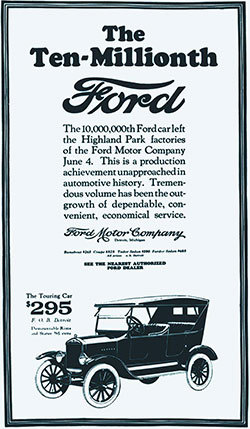 Henry Ford said, “I will build a car for the great multitude. It will be large enough for the family, but small enough for the individual to run and care for. It will be constructed of the best materials, by the best men to be hired, after the simplest designs that modern engineering can devise. But it will be so low in price that no man making a good salary will be unable to own one.”
Henry Ford said, “I will build a car for the great multitude. It will be large enough for the family, but small enough for the individual to run and care for. It will be constructed of the best materials, by the best men to be hired, after the simplest designs that modern engineering can devise. But it will be so low in price that no man making a good salary will be unable to own one.”
It took Henry Ford almost a decade to find a product that could fulfill his Bold Vision. He produced his first car in 1901, and between 1903 to 1908 Ford produced the Models A, B, C, F, K, N, R, and S.
Henry Ford didn’t achieve his vision until he produced the Model T. The Model T democratized the automotive industry, and took cars from a toy of the rich to a tool of the masses.
Henry Ford’s Bold Vision was powerful and effective, because it was anchored on a Big Idea. He saw a world where “everybody will be able to afford [a car], and everyone will have one.”
In the early 1900’s the idea of universal car ownership seemed far fetched. People used trolleys, trains, and horses to travel. But Ford understood the technology of the day, and how it could be harnessed. He presented a vision of what to build and who to build it for.
A Bold Vision acknowledges where we are today, and presents an idea of where to go next. It’s a simple, deliberate statement of what the future could be.
A Bold Vision Has a Finish Line
A mission statement is timeless, but a Bold Vision has a conclusion. There’s a Finish Line.
 John F. Kennedy gave congress a time line, “before this decade is out,” and a Finish Line, “landing a man on the moon and returning him safely to the earth.” It was a complete vision of what the country had to accomplish.
John F. Kennedy gave congress a time line, “before this decade is out,” and a Finish Line, “landing a man on the moon and returning him safely to the earth.” It was a complete vision of what the country had to accomplish.
A Bold Vision has a destination, which is contrary to what we expect of a mission or vision statement. It doesn’t have to live for the life of the organization. Rather it’s a moment in time where you rally and focus your organization on one primary objective.
Kennedy’s Bold Vision has two defining elements:
A deadline: “Before this decade is out.” The statement accelerated the “space race” between the United States and the Soviet Union.
Parameters for success: “landing a man on the moon and returning him safely to the earth.” The United States wasn’t simply going to the moon. They were going there, walking around, and coming home safely. It was a complete journey.
Defining the Finish Line gives your team a destination. It focuses them on an outcome, and that feeds their creativity and energy.
A Bold Vision Is a Compelling Lens
A Bold Vision paints a picture in your mind. It makes a Big Idea tangible.
NASA’s current mission statement reads, “Drive advances in science, technology, aeronautics, and space exploration to enhance knowledge, education, innovation, economic vitality, and stewardship of Earth.”
I’ve read NASA’s mission statement a dozen or more times, and I still cannot repeat it, share it, or even remember it. It has nice words, but I cannot picture how “advances in sciences” and other stuff will help me, or what the organization will accomplish.
A Bold Vision is like a lens. It makes a vision of the future clear and accessible.
Language is an essential ingredient of a Bold Vision Statement. When the statement is easy to grasp, it becomes easy to share.
Iconic vision statements have a poetic quality:
Bill Gates, Microsoft: Put a computer on every desk and in every home.
George Eastman, Kodak: Make photography as convenient as using a pencil.
Marc Benioff, Salesforce.com: The End of Software.
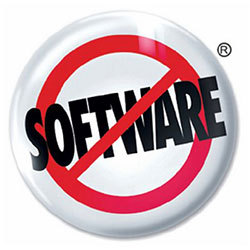 Each vision statement challenges the present, at least at the moment it was created, and provides a lens for the organization.
Each vision statement challenges the present, at least at the moment it was created, and provides a lens for the organization.
Salesforce.com’s vision was to transform business solutions from client-server software — software that is installed and maintained inside your office — to cloud based applications. When Salesforce.com embarked on this journey the idea seemed crazy, but today cloud computing is the new normal.
Crafting the words into a compelling statement brings a Bold Vision to life.
A Bold Vision Is Omnipresent
A Bold Vision isn’t shared once and forgotten. It’s repeated ad nauseam. The CEO brings it up in almost every conversation. It’s plastered on the walls. It’s written in strategic plans. It’s the focal point of every leader, manager, and employee.
It’s the CEO’s priority and job to make it Omnipresent. The CEO has to keep the Bold Vision front and center every single day.
In Team of Teams — one of my favorite leadership books of the past three years — General Stan McChrystal writes, “Experience had taught me that nothing was heard until it had been said several times. Only when I heard my own words echoed or paraphrased back to me by subordinates as essential ‘truths’ did I know they had been fully received.”
Repetition is key. As soon as you stop communicating the Bold Vision it loses its effectiveness.
Jim Gilbert, CEO of Wheels and Deals, assumes his team forgets everything he taught them about his organization’s Bold Vision and brand at the end of each week. It’s like someone hits a reset button on Friday at 5pm, and he has to retell the story again on Monday.
Jim told me that he often feels like a broken record, but he is motivated by a core belief, “If I miss a week it costs me two, and if I miss two weeks it costs me four.” This means it takes twice as long to get your team back on track if you stop reinforcing your Bold Vision.
A Bold Vision Requires Zealous Commitment
An organization cannot achieve a Bold Vision without the Zealous Commitment of its leadership.
A Bold Vision is transformative. Your organization isn’t going to achieve it in 0 to 12 months. Realistically, a Bold Vision is going to consume your organization for the next 3 to 5 years.
Five years is a lifetime for employees and managers. They are focused on the here and now. They have quarterly priorities and annual objectives. A Bold Vision has to overcome the tyranny of the now, and drive your team for a result that could take years to accomplish.
“When it comes to making a big bet on your next big thing, pick one,” writes Geoffrey Moore in Zone To Win. “This is the single most important job of a CEO. Choose one thing to be your enterprise’s next big thing, and then deliver on that future — to customers, to shareholders, to partners, to employees, and to your industry as a whole.”
Under Steve Jobs’ leadership, Apple transformed itself, and the consumer electronics industry, four times: first with the iMac, then with iTunes and the iPod, then the iPhone, and finally with the iPad. Each product took a Zealous Commitment from Apple’s leadership and employees to bring to market.
Steve Jobs drove Apple relentlessly to launch each product. He aligned his management teams. He cancelled or delayed projects and priorities so that each product had the talent and resources it required to be successful. He led Apple to achieve each Bold Vision with unwavering commitment.
You cannot change the future without Zealous Commitment. In other words, building a great organization requires good management, but achieving a Bold Vision requires extraordinary leadership.
July 19, 2016
The Battle for Relevance: Why Change Matters

For a decade or more there has been a steady drum beat: change, change, change.
We hear it almost on a daily basis, “The pace of change is accelerating.” For instance, a recent study by the Economist Intelligence Unit (EIU) found that 96% of executives surveyed agreed that change is accelerating, and 62% reported that the pace of change related to digital transformation is “accelerating significantly” in their industry.
We feel the pace of change, and we can see it. There are disruptive companies like Uber and Airbnb, and disruptive technologies like 3D printing and VoIP. The signs of change are everywhere.
But so what? Change is just a fact of life. Why is this topic garnering so much attention?
I’ve been turning this question over in my head for months, and then it dawned on me. Change matters, because it affects relevance.
Disruption Leads to Irrelevance
The taxi industry is fighting Uber tooth and nail, because ride hailing is making the taxi companies irrelevant.
Ride hailing is the disruption. The taxi industry’s business model is tied to telephone dispatch and having cars available in popular spots. A ride hailing app, like Uber or Lyft, makes that infrastructure irrelevant.
Once you’ve hailed a car from your phone you never want to call a taxi company again.
The taxi industry is fighting back by targeting UberX and unlicensed commercial drivers, but this a short term battle. The war for relevance is in ride hailing, which will be an uphill battle for the taxi companies.
It’s Better To Be Hated Than Irrelevant
Gene Simmons said, “People either love KISS or hate us with all of their guts, and that’s the way we like it.”
There’s a real gem in this quote. Irrelevance is the worst place for a brand. Love and hate are visceral emotions. They take energy, commitment, and knowledge. Irrelevance, on the other hand, is purgatory. Your brand may exist, but no one cares.
When a market is disrupted there are winners and losers. The winners gain relevance, and the losers lose relevance.
When a brand faces the losing side of disruption this is a battle cry. What made you successful won’t make you successful. The rules have changed, and it’s time to re-examine everything. If you hesitate your brand may become irrelevant.
The Battle For Relevance
The taxi industry cannot win against Uber through legislation alone. They’ve got to adapt and change, especially with their business model.
To overcome a disruption there are two fundamental strategies:
Differentiate: Find a way to out innovate the innovator. This is usually a long shot, but sometimes a company can find a way.
Neutralize: The more effective approach is to neutralize the competition. They’ve leapfrogged over the industry. Now it’s your turn to counterattack with a comparable solution — something that’s “good enough” — so that you can commoditize their advantage.
The stakes are high in either scenario, but you’ve got to fight. When the pace of change is accelerating you have to constantly strive to gain relevance at the expense of others.



